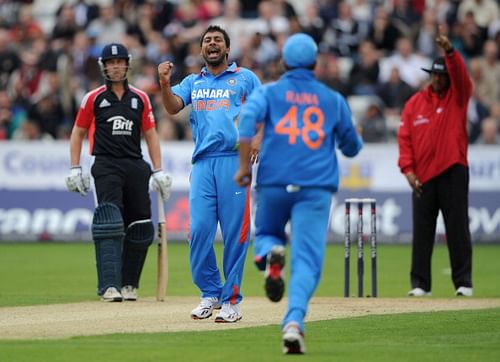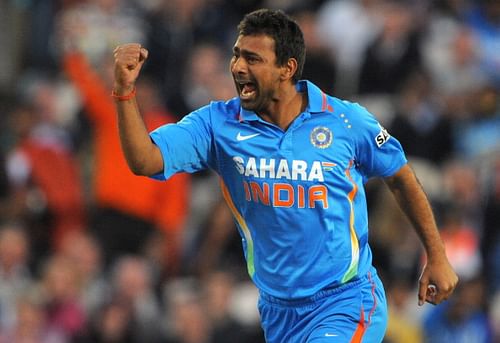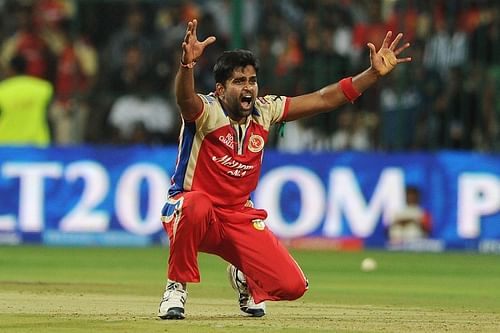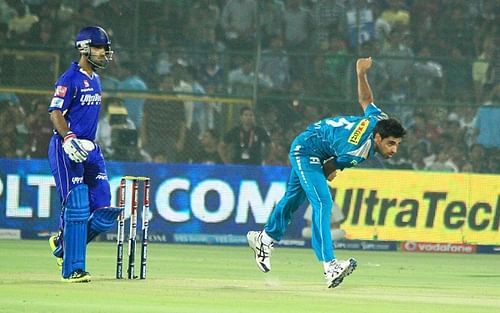
Emergence of India's swing arsenal - Praveen, Vinay and Bhuvneshwar Kumar

Swing bowlers are to cricket what cliches are to the English language – abundant in number and used too often, yet maintaining their significance most times. Life is tough for a medium pacer and the cruelty of this sport, grossly favouring batsmen, makes the battle of survival unbearable and almost one-sided. They all lack raw pace and the only weapon in their armoury is their swing. The very skills of a swing bowler – his ability to read the batsmen’s minds, mix up his pace, apply variations and keep the batsmen guessing – his unpredictability is what sets him apart from others and churns out the cream from the milk.
Gone are the days of Richard Hadlee, Joel Garner, Marshall and Lillie; gone are the days when the batsman wouldn’t dare step out of the crease without a helmet, petrified and awed by the sheer superiority of the pacers like a terrified goat gazing at his majestic hunter, shaking with fear. Those times are history; the dinosaurs of cricket have retreated to their own shells albeit not before leaving behind a couple of progenies like Dale Steyn and Brett Lee. Welcome to modern day cricket – dominated by the descendants of Don Bradman and Viv Richards and assisted by the glimpses of Shane Warne and Bishen Singh Bedi.
The ancestry of today’s swing bowlers can be traced back to Wasim Akram and Waqar Younis, who paired up to haunt the greatest of batsmen in their living nightmares. The cherry appeared to perform sorcery when delivered from their hands, the destination of which the batsmen couldn’t fathom, the curves of whose trajectory no artistic physicist could plot. However, the current pool of swing bowlers have to undergo gruelling auditions before selection, courtesy their ever increasing number and lack of infinite brilliance in an individual.
Coming to India, after the eras of Kapil Dev and Javagal Srinath, it’s been Zaheer Khan who has spearheaded the swing attack for the last decade. As age catches up with him and he gradually loses lustre, it ultimately cuts down to three young “veterans” who would have to shoulder the bulk of the responsibility in the coming years – Praveen Kumar, Vinay Kumar and Bhuvneshwar Kumar.
Before his international debut, Praveen Kumar had been Uttar Pradesh’s go-to man for a long time. He has splendidly made up for his deficiency of genuine pace with his brilliant ability to swerve the balls both ways. His ability to bat responsibly down the order makes him a perfect No. 8 for any team.

Praveen Kumar’s X-factor lies in his persistence of bowling long spells and keeping up the rhythm for a long time. His ability to swing it away from the batsman earlier in the innings makes him just as much difficult to hit as his slow bouncers during the death overs. He’s been a key member of the Indian side ever since his debut against Pakistan in 2007 where he claimed 10 wickets in four matches, till he was banned by the BCCI for breaching the Code of Conduct in the domestic season recently (The ban was eventually lifted and Praveen was let off with a severe reprimand). Praveen is the most experienced campaigner among the three and the entire duty of guiding the youngsters rests on his shoulders.
At 29 years of age and with only one Test match experience, one has to admit that Ranganath Vinay Kumar has come of age. Indeed, he had been thrown into spotlight via the IPL when his repeated success at the domestic level went unnoticed. Debuting with 12 five-wicket hauls and 3 ten-wicket hauls in first class career, a lot was expected from Vinay Kumar against Zimbabwe in 2010.

Looking at his stats, one would say he hasn’t disappointed with a decent average and economy in ODIs, if the forgettable Test debut at Perth is not to be considered. Out-swingers and leg-cutters remain his chief weapons while his accuracy is something every bowler will be envious of. His in-swinging variations also prove to be effective at times, particularly when he takes the pace off the ball. Vinay Kumar continues to dazzle in the domestic league with the Royal Challengers Bangalore and an Indian fan only hopes he carries on the good form in the Blue jersey.
Hailing from the same town of Meerut as Praveen Kumar, India’s youngest swing sensation Bhuvneshwar Kumar grabbed his opportunity as early as his 11th first class match where he dismissed Sachin Tendulkar to his first duck in Indian domestic cricket. A couple of impressive seasons in the Ranji Trophy earned him the India-A cap and eventually the Indian cap at international level.

He amazed the cricketing world with his debut ball (in last year’s ODI against Pakistan) which swung in sharp from outside the off-stump to bamboozle the batsman and claim his stumps. In his T20I debut also against Pakistan, he displayed his excellence too earlier, claiming 3/9 with some fiery inswingers. Close analysis reveals the ball leaving his fingers at an angle, swinging outward while in the air and then altering its course, thus coming in sharply towards the leg-stump just after pitching. The Pakistanis were foxed by his swing at a decent pace and the successful debut earned “Bhuvi” his Test cap.
He also impressed against the Australians with his ability to extract swing in both directions and earned the praise of selectors and pundits alike. In addition to his exploits with the kookaburra, Bhuvneshwar also comes in handy with the bat, which is evident from his 11 50s and a century in first-class cricket. Slated as the next big thing in the decaying Indian bowling line-up, it remains to be seen whether Bhuvneshwar does justice to his talent or extinguishes like many of his predecessors. He is young, he is talented, and proper guiding and coaching will ensure he matures from a good bowler into a great bowler within the next five years.
With three competent swing bowlers leading the attack, India may continue to rely on the trend of not express pace, but their swing bowling. Only time will tell whether PK, VK and BK actually manage to swing matches in the Men in Blue’s favour.